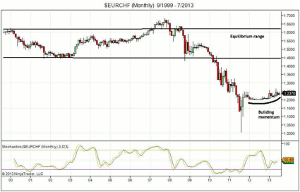Trading the Euro-Swiss during the past 18 months has been really boring as there has been very little movement, but that can soon change, writes Tim LuCarelli of FXAddicts.com.
Currencies are truly different animals in that everything affects them. If you are a grain trader then weather, ground moisture, supply and demand, exports and imports affects your focus. All of these influence currencies along with everything else you can think of as a tradable commodity.
Political events influence everything but will have a stronger influence on currencies. For instance, if there is a political event in Kuwait, it will affect most obviously oil and most certainly the US dollar as oil is traded in dollars. However, it will have very little affect, if any, on orange juice; point being everything affects currencies.
Currencies are by far the most influential group of tradable instruments. Every transaction involves currencies and is therefore influenced by everything else.
Trading a currency pair is very exciting if there is action in one of the currencies. If there is no action, then it can be incredibly boring. The EUR/CHF has been one of those boring currencies for the last 18 months. Since the Swiss National Bank (SNB, Switzerland's Central Bank) set a floor of 1.200 euros per franc in September 2011, there has been very little movement in the pair. Prior to that stabilization act, this cross was a wild beast.
What once was will again be! History repeats itself. The EUR/CHF will once again become a wildly tradable beast.
A currency cross is in and of itself its own market. The differences in the two economies, political beliefs, and social structure all make up the cross' valuation. Europe and Switzerland are two very dynamic economies with a true symbiotic relationship. They both would have a hard time living without the other; of course political heads of both would deny such a relationship.
Switzerland is a major tourist destination for many Europeans; shopping, skiing, and sightseeing. More importantly, there are several Swiss industries on which the rest of Europe relies, most notably banking, insurance, and manufacturing. Switzerland needs the large population from Europe to take advantage of its manufacturing and services industries. Money from Europe flows to Switzerland for all of these reasons producing economic benefits for both sides.
On the other hand, Switzerland is a small country lacking in the raw commodities necessary to feed its manufacturing industry. Because of its size, it also relies on the rest of Europe for a lot of its human talent. All of this causes money to flow from Switzerland to the rest of Europe. Europe, because of its many countries and different laws, would find itself at a loss without Switzerland's well-established infrastructure.
This symbiotic relationship kept the currencies of Europe and Switzerland in a balanced but highly volatile state for many years. That balance was upset in 2010 when money flowed to Switzerland for safety purposes as fear grew that the European Union could break up. That flow created an artificial bubble in the Swiss franc.
Above is a monthly chart of the EUR/CHF going back just about 14 years. It has now been two years since the spike low and just about two years since the SNB set its floor of 1.200 euros to the franc. The artificial floor created by the SNB stopped the cross from technically testing its spike low. That artificial floor, by keeping the cross from testing its lows, set up a time requirement for the cross to work through its overly negative tone; it has now worked through that negativity.
On this long-term chart, it becomes a little easier to see how the cross is building momentum to move higher. The move higher will eventually get it back to its equilibrium range between 1.45 and 1.63. That equilibrium range represents a fair valuation between the two countries' economic structures.
The decline in the euro's value, relative to the franc, broke the base of the equilibrium level and bottomed out in 18 months. The run back to that equilibrium range will most certainly take longer and will pick up volatility on the way.
For now, the cross represents a great opportunity for anyone that can stomach the risk to 1.200 as the SNB has created a guaranteed stop. Because of the floor created by the SNB, playing this market over the last 18 months has been a no brainer. It will continue to be until the risk outweighs the reward. That point is a determination for each individual trader by allocating funds necessary to hold any positions to that 1.200 floor.
By Tim LuCarelli of FXAddicts.com






















